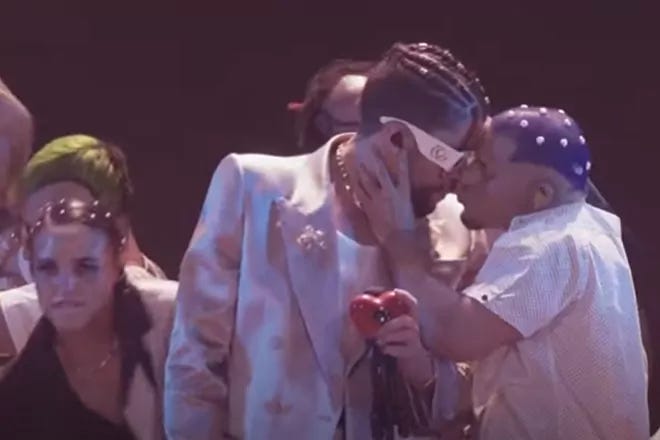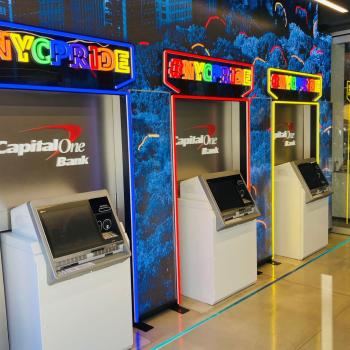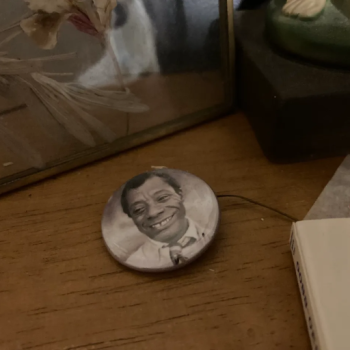
Reactions to Bad Bunny’s same sex kiss on the 39th annual MTV Video Music Awards have been painstakingly predictable, as if being read off of a script. From those celebrating his bold statement of self-acceptance and his disavowal of machismo and homophobia, to those highlighting his white-passing and cis-male privilege and those condemning the act as “queerbaiting,” most would not be alarmed were they to find out that the proliferation of news headlines and social media posts were generated by an algorithm. Rare are those who dare, or who even possess the capacity, to conceive of an original thought in an age so devoid of nuance as our own.
What’s most shocking is perhaps the fact that the public is so shocked by Bad Bunny’s public “statement”…or lack thereof. Since the dawn of his career, Bad Bunny has proven himself a master of the spectacle. He is a sensationalistic performance artist extraordinaire. And like most feats of postmodern performance art, his ubiquitous public presence draws attention for the sake of attention, lacking real substance nor pointing to any ideals that transcend himself. His glamorously artificial persona is largely the product of corporate calculation and marketing genius.
The promotional content for his albums have been rife with performative flair. For the release of his second solo album, he wore the release date on the back of a basketball jersey while playing at an All Star game, then posted a series of cryptic Tweets hinting at the title and number of tracks on the album. For his third album, he gave an impromptu concert while riding on top of a truck in Washington Heights, New York. And for his latest, he posted a classified ad for a used car with a phone number. Those who called the number would receive a text with information about the album’s release.
His Instagram posts cement his omnipresence into public consciousness, with numerous images of himself posing nude or in genderbending attire making their way to his fan’s feeds and far beyond into the realm of merchandise like t-shirts, AirPod cases, car air fresheners, and party favors (courtesy of various Etsy shops). Rather than being a statement-maker or game-changer, he is an emblem of the artifice of our times…of our fixation with banality and glorification of that which lacks substance.
His “label-less” sexuality is a projection of the mores of our postmodern moment, in which nothing is fixed, opposing forces are neutralized, and differing values are rendered indistinguishable from each other. His flippancy in his relationship with his girlfriend Gabriela Berlingeri (rumor has it that they are in an open relationship, and at an afterparty he was seen kissing another woman) has been sensationalized by social media–with TikTokers both celebrating his moral progressivism and condemning his machismo.
His painting his nails, wearing skirts, carrying a handbag, and dressing in drag for one of his music videos, and his advocacy for violence against trans Puerto Ricans and willingness to bring a transgender reggaetonerx on stage to perform with him, have gained him the cheers of activists for his willingness to challenge the general attitude of disapproval toward homosexuality and effeminacy in Latin American countries.
When asked about whether he considers himself bisexual, he responded “it [bisexuality] does not define me. At the end of the day, I don’t know if in 20 years I will like a man. One never knows in life.” His unwillingness to be held down by categories, genders, or individual people testifies to the shifting tide toward “liquid modernity,” which sociologist Zygmunt Baumann describes as an ethos in which “everything could happen yet nothing can be done with confidence and certainty.”
The fact that his sexual libertinism stirs up the public as much as it does is, again, more shocking than his sexual libertinism itself. Can we really claim to be surprised by a public figure who is merely living out our day’s “ethic of authenticity” to its furthest limits? He dares to take the saying that we ought to “follow our heart’s desire” at face value, or, as the title of his second album proclaims, “yo hago lo que me da la gana” (I do whatever I want).
In addition to those who critique him for his privilege or undercover machismo are those who critique him for less “popular” reasons. Some more traditionally minded viewers have expressed concern that he is corrupting the morals of the youth, influencing them to crossdress and experiment sexually (I’ve met many teenage boys who have started painting their nails “because Bad Bunny does it”). Latinos carry the painful wounds of Spanish colonization to this day…thus they are wary of the threat of an ideological colonization, this time, by the hands of one of their own.
The general disapproval of homosexuality amongst colonized (especially Latino) cultures is rooted in its symbolism. Songs like Shabba Ranks’ 1990 song “Dem Bow” goes as far as equating male homosexual sex to black Jamaicans being dominated by the power and lax morals of white British colonizers (who many claim brought the practice of sodomy to the Caribbean). Further, as thinkers like John Milbank have expressed, such attitudes toward sexual fluidity put more at stake for impoverished and historically oppressed communities than for privileged elites.
It’s worth noting that this wasn’t the first time the MTV VMA’s has presented a same sex kiss, nor has it been lacking in other sensationalistic moments that have won the attention of the public–from the Britney-Madonna-Christina kiss in 2003, to the Kanye-Taylor debacle in 2009, to the Miley-Robin Thicke twerk session in 2013.
A perhaps less socially acceptable critique that lurks from the fringes of the internet are accusations that such displays on award shows are part of occult initiation rituals, positing that these bizarre spectacles serve to elevate certain celebrities into the upper echelons of the elites, while “sacrificing” others to be eaten alive by public scrutiny and disapproval. But maybe such claims are the stuff of outlandish conspiracy theories…perhaps MTV is just desperate to maintain their viewer count and stay relevant.
Either way, these artists never seem to be the same after their “ritualistic” appearances on the VMAs. For the “initiates,” their aesthetic and public image tend to become edgier and begin to deal with content that is more explicitly violent or sexual (and sometimes does employ imagery and symbolism that evoke the occult). While those who are “sacrificed” usually end up having a series of public breakdowns, whether due to demonic possession and mind control, or the overwhelming stress of newfound fame and public scrutiny, or perhaps to a random onset of bipolar disorder…like most matters in our liquid modern times, we can’t be certain.
Whether you applaud his statement against homophobia, sneeringly remind us of his white-passing and cisgender male privilege, think he’s corrupting the morals of the youth, is an ideological colonizer spreading the agenda of globalist homogenization, or was initiated in an occultic megaritual, all these “hot takes” converge here: Bad Bunny is a master of the spectacle, an emblem of the sensationalism of our time, and of our susceptibility to being allured by liturgies of nothingness. He continues to hold our attention, as we continue to earnestly post our opinions and analyses.
The real question is not whether to applaud or morally censure him. The question shouldn’t even be directed toward Bad Bunny himself, but rather to the public: why do we sensationalize that which is banal, allow an unremarkably predictable act to hold our attention and generate such public fanfare? The fact that our collective consciousness is dominated by such spectacles calls into question the lack of substance in our own day to day lives. Dare we look into the mirror that Bad Bunny is holding up to our faces?
$upport CracksInPomo by offering a donation through Anchor
For further reading on Bad Bunny, check out my other articles here:
Bad Bunny is a spiritual guide for our postmodern times
Bad Bunny’s YHLQMDLG: the Downside of Forgetting Your Problems
Bad Bunny’s “New Religion”: Optimistic Nihilism in Pop Music Pt. 1
The Inconvenience of Complacency: Optimistic Nihilism in Pop Music Pt. 2
Suicide, the Occult, and the Next Generation: Optimistic Nihilism in Pop Music Pt. 3
cover photo courtesy of MTV-YouTube












